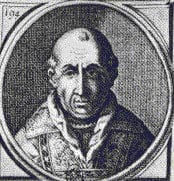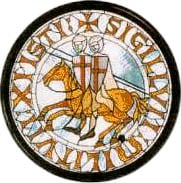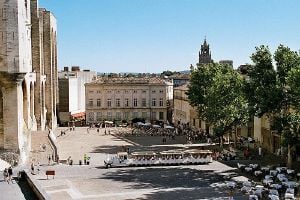| Clement V | |
|---|---|

| |
| Birth name | Raymond Bertrand de Got |
| Papacy began | November 14, 1305 |
| Papacy ended | April 20, 1314 |
| Predecessor | Benedict XI |
| Successor | John XXII |
| Born | 1264 Villandraut, Gascony, France (?) |
| Died | April 20 1314 Avignon, France |
| Other popes named Clement | |
Pope Clement V (1264 – April 20, 1314), born Bertrand de Goth (also occasionally spelled "Gouth" and "Got"), was Pope from 1305 to his death. He is memorable in history for suppressing the order of the Templars, and as the Pope who moved the Roman Curia to Avignon in 1309. He was Philip IV The Fair's personal choice for Pope, and more or less served Philip's interests. However, despite a reputation for greed and weakness, he did not lack courage. Initially, he was reluctant to suppress the Templars and also refused to condemn Boniface VIII, which Philip allegedly made a condition of supporting his papacy. More interested in honors and in sinecure than in spiritual leadership, his tenure as pope was not entirely a failure. No Pope could survive at this time without strong support from a temporal ruler or rulers, and Italy was an increasingly dangerous place, described by Shahan as "quasi-anarchical" at the time.[1] The claim that the move to Avignion was to protect the papacy was not entirely false. Clement, weak though he was and in many respects the pawn of the French king, did retain some self-dignity and independence. In the matter of condemning Boniface VIII, says Chamberlain, "Clement, pliant creature of the king though he was cheated him of this last satisfaction" and "the trial never came to a verdict."[2]
Clement may have sincerely wanted to serve God. He did his best, within difficult circumstances, to protect the prestige of the papacy, even if he was not its most able, saintly, or visionary incumbent.
Biography
Born in Villandraut, Aquitaine, Bertrand was canon and sacristan of the church of Saint-André in Bordeaux, then vicar-general to his brother, the archbishop of Lyon, who in 1294, was created Cardinal Bishop of Albano. He was then made bishop of St Bertrand-de-Comminges, the cathedral church of which he was responsible for greatly enlarging and embellishing; and chaplain to Pope Boniface VIII (1294–1303), who made him archbishop of Bordeaux in 1297. Technically, Bertrand was a subject of the King of England, whose territory included Bordeaux.
Papal election
Following the death of Benedict XI in 1304, he was elected Pope Clement V in June 1305 (and was consecrated on November 14), after a year's interregnum occasioned by the disputes between the French and Italian cardinals, who were nearly equally balanced in the conclave, which had to be held at Perugia. Bertrand was neither Italian nor a cardinal, and his election might have been considered a gesture towards neutrality. The contemporary chronicler, Giovanni Villani, reported gossip that he had bound himself to King Philip IV of France (1285–1314) by a formal agreement previous to his elevation, made at St. Jean d'Angély in Saintonge. Whether this was true or not, it is likely that the future pope had conditions laid down for him by the conclave of cardinals. He had, however, known Philip since his own youth. At Bordeaux, Bertrand was formally notified of his election and urged to come to Italy; but he selected Lyon for his coronation, November 14, 1305, which was celebrated with magnificence and attended by Philip IV. Among his first acts was the creation of nine French cardinals.
The king and the popes
Philip IV The Fair of France's understanding of his role as God's representative on earth ran counter to the teaching of the Catholic Church, strongly upheld by Boniface VIII and his successor, Benedict XI that the Pope was God's representative in both the temporal and the spiritual realm. The papal coronation included the words, "Know that thou art the father of princes and kings—the ruler of the world" and some Popes took this to "its logical end."[3] According to Howarth, the Capetian kings believed themselves, or were believed to be by their subjects, "semi-divine" whose "touch, reputedly, could cure disease."[4] In his self-understanding, Philip was a "priest-king" and so felt entitled to tax the clergy, even though this contravened papal authority. It was this self-understanding that brought Philip into direct conflict with Pope Boniface VIII, "whose will was as strong as Philip's, and whose dream was identical, the union of all authority, temporal and spiritual, in his person."[5] Boniface issued the bull, Unam Sanctam, proclaiming his authority over kings, and excommunicated the money-strapped Philip for levying taxes on the Church. Philip responded by arresting one of the French Bishops known to be close to the Pope, and by convening an Assembly of French nobles, scholars, and prelates that condemned the Pope. Philip then dispatched his agent, William Nogaret, to Anagni, the Pope's summer retreat in the hills east of Rome to arrest Boniface himself. Boniface was rescued by the people of the city three days later, but died within a month. His successor, Benedict was "cast in the same mold" but was himself dead within the year. It was at the subsequent papal election that the French archbishop Bertrand de Goth was elected pope as Clement V with Philip's enthusiastic strong support. Howarth (1982) says that Philip:
knew what he was doing in supporting de Got's nomination; he knew the man well. The archbishop was a weak and greedy man, fond of honor and disliking responsibility; he had attained his archbisopric through family influence, for his uncle was a bishop and his brother an archbishop.[6]
Clement knew that he was Pope because of Philip's support, and he restored the King to good standing. Early in 1306, he explained away those features of the bulls Clericis Laicos that might seem to apply to the King of France and essentially withdrew Unam Sanctam, the two bulls of Boniface VIII which were particularly offensive to Philip IV's ambitious ministry. He appears to have conducted himself throughout his pontificate as the mere tool of the French monarchy, a radical change in papal policy.
Suppression of the Knights Templar
On October 13, 1307, came the arrest of hundreds of the Knights Templar in France, an action apparently financially motivated and undertaken by the efficient royal bureaucracy to increase the prestige of the crown. Philip IV was the force behind this ruthless move, but it has also tarnished the historical reputation of Clement V. From the very day of Clement V's coronation, the King had charged the Templars with heresy, immorality, and abuses, and the scruples of the Pope were compromised by a growing sense that the burgeoning French State might not wait for the Church, but would proceed independently. Clement was initially slow to respond to these charges and "with considerable courage … refused to give the king an answer … at once."[7]. He tried to "fend off" Philip's "demand for an inquiry" until Philip ordered the arrest of all members of the order. Clement interpreted this as an attack on the Church itself, and issued a bull ordering the "kings of the Christian lands … to arrest the Templars in their countries" but to do so in the name of the Pope.[8] Clement may have hoped that the Templars' innocence would be proved, so yielded to the King's pressure to move against them. However, charged with heresy, sodomy, and all manners of abominations, they were, despite Clement's delaying tactics, eventually found guilty. Clement tried to avoid taking personal responsibility by sending a delegation of Cardinals to Paris to interrogate the prisoners.
In 1311, Council of Vienne was convened to pass judgment. Most of its 300 members thought the charges unproved but Philip himself testified to the order's guilt. Then, the Bull Vox in excelsis, dated March 22, 1312, written by Clement, was read. In this Bull, "the pope said that though he had no sufficient reasons for a formal condemnation of the order, nevertheless, because of the common weal, the hatred borne them by the King of France, the scandalous nature of their trial, and the probable dilapidation of the order's property in every Christian land, he suppressed it by virtue of his sovereign power, and not by any definitive sentence." Many of the knights were executed, and the order's wealth was confiscated. Although the order's assets were meant to devolve to the Hospitallers, they were appropriated by Philip. The guilt or innocence of the Templars is one of the more difficult historical problems, partly because of the atmosphere of hysteria that had built up in the preceding generation and the habitually intemperate language and extravagant denunciations exchanged between temporal rulers and churchmen, and partly because the subject has been embraced by conspiracy theorists and pseudo-historians. Shahan suggests that Clement may have given in on the issue of the Templars in order to strengthen his own hand in resisting Philip's desire to have Boniface condemned, "to stand for both with Apostolic courage might have meant intolerable consequences, not only personal indignities, but in the end the graver evil of schism under conditions peculiarly unfavorable for the papacy."[9]
The Babylonian Captivity
In March 1309, the entire papal court settled at Avignon, which was not then part of France but an imperial fief held by the King of Sicily. The removal of the Papacy to Avignon was justified at the time by French apologists on grounds of security, since Rome, where the dissensions of the Roman aristocrats and their armed militia had reached a nadir, and where the Basilica di San Giovanni in Laterano had been destroyed in a fire, was unstable and dangerous. But the decision proved the precursor of the long Avignon Papacy, the "Babylonian captivity" (1309–77), in Petrarch's phrase, and marks a point from which the decay of the strictly Catholic conception of the pope as universal bishop may be dated.
Meanwhile, Philip IV's lawyers pressed to reopen Nogaret's charges of heresy against the late Boniface VIII that had circulated in the pamphlet war around Unam sanctam. Clement V had to yield to pressures for this extraordinary trial, begun February 2, 1309, at Avignon, which dragged on for two years. In the document that called for the witnesses, Clement V expressed both his personal conviction of the innocence of Boniface VIII and his resolution to satisfy the King. Finally, in February 1311, Philip IV wrote to Clement V abandoning the process to the future council of Vienne. For his part, Clement V absolved all the participants in the abduction of Boniface at Anagni. During his pontificate, Clement elevated five members of his own family to the college of Cardinals.[10] He canonized the former Pope, Celestine V (pope for five months and eight days in 1249), whom Boniface had imprisoned (as St. Peter). Celestine had been a hermit before his election as Pope, and was the candidate of a reformist party. Generous to a fault, he "reduced the bureaucracy to chaos with his casual gifts."[11] Oddly, Celestine's brief papacy (he resigned, and was then imprisoned by his successor, who feared that he still had a claim to be the legitimate Pope) suggests that a deeply spiritual man was actually, as pope, an "anomaly—the power to be exercised was the same type as that exercised by any other monarch."[12]
Italy and Clement's pontificate
Clement V's pontificate was also a disastrous time for Italy. The Papal States were entrusted to a team of three cardinals, but Rome, the battleground of the Colonna and Orsini factions, was ungovernable. In 1310, the Emperor Henry VII (1308–13) entered Italy, established the Visconti as vicars in Milan, and was crowned by Clement V's legates in Rome (1312) before he died near Siena in 1313. However, Clement threatened the Emperor with excommunication in 1313, over his intent to wage war against Robert of Naples, whom Clement declared Emperor after Henry's death.
In Ferrara, papal armies clashed with Venice. When excommunication and interdict failed to have their intended effect, Clement V preached a crusade against the Venetians, a symptom of how polarized that particular conflict had become.
England, Scotland, and Clement V
Clement intervened in a dispute between Edward I of England and the Archbishop of Canterburry, supporting the former and suspending the latter. He excommunicated Robert Bruce in 1306, for murdering his rival, John Comyn during mass. He also deposed several Scottish bishops supporting a national uprising against English rule.
Suppression of the Fra Dolcino
Other remarkable incidents of Clement V's reign are his violent repression of the Fra Dolcino, a reformist movement which he considered a heresy, in Lombardy, and his promulgation of the Clementine Constitutions in 1313. The Dolcino opposed the hierarchy, the feudal system, supported individual freedom and preached equality and common ownership of property. They denounced the worldly power and wealth of the papacy. Various popes, who found themselves answering criticism of their worldly power and possessions, replied that in order to serve and not to be served, the Church needed to be wealthy.
Death and legacy
Clement V died in April 1314. According to one story, while his body was lying in state, a thunderstorm developed during the night and lightning struck the church where his body lay, igniting the building. The fire was so intense that, when it was extinguished, the body of Pope Clement V was almost completely destroyed. He is buried at La Chaise-Dieu in Auvergne.
Clement V is often remembered for his alleged nepotism, reported avarice, weakness, and cunning, and is often vilified as a willing collaborator in the designs of France against the Pope, who ushered in a century of schism: In the Divine Comedy, Dante is shown the place which awaits Clement V in the eighth circle of Hell. He is recorded as the first pope to be crowned with a papal tiara. Chamberlain described Clement as "the timorous pope, who … cowered benathy the French king."[13] On the other hand, he was courageous in initially opposing Philip's move against the Templars and in resisting the King over Boniface's condemnation, even though he owed his own position to the French king. Clement also published some writings on Canon Law, the Clementinae. Duffy describes Clement as a "good administrator." He was "deeply committed to the crusading ideal" and also consolidated the relationship between the Church and the Universities, "founding chairs in Oriental languages at Paris, Oxford, Bologna, and Salamanca."[14]
Notes
ReferencesISBN links support NWE through referral fees
- Chamberlain, E. R. The Bad Popes. NY: Barnes & Noble, 1993. ISBN 9780880291163
- Duffy, Eamon. Saints and Sinners: A History of the Popes. New Haven, CT: Yale University Press, 2006. ISBN978-0300115970
- Howarth, Stephen. The Knights Templar. New York: Barnes and Noble, 1982. ISBN 9780880296632
- Maxwell-Stuart, P. G. Chronicle of the Popes: The Reign-by-Reign Record of the Papacy over 2000 Years. London: Thames & Hudson, 1997. ISBN 978-0500017982
- Menache, Sophia. Clement V. Cambridge: Cambridge University Press, 2002. ISBN 0-521-52198-X
External links
All links retrieved December 19, 2023.
| |||||||||||||
Credits
New World Encyclopedia writers and editors rewrote and completed the Wikipedia article in accordance with New World Encyclopedia standards. This article abides by terms of the Creative Commons CC-by-sa 3.0 License (CC-by-sa), which may be used and disseminated with proper attribution. Credit is due under the terms of this license that can reference both the New World Encyclopedia contributors and the selfless volunteer contributors of the Wikimedia Foundation. To cite this article click here for a list of acceptable citing formats.The history of earlier contributions by wikipedians is accessible to researchers here:
The history of this article since it was imported to New World Encyclopedia:
Note: Some restrictions may apply to use of individual images which are separately licensed.

